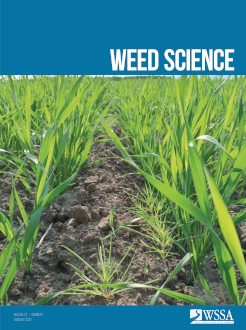Palmer amaranth (Amaranthus palmeri S. Watson) is a major biotic constraint in agronomic cropping systems in the United States. While crop–weed competition models offer a beneficial tool for understanding and predicting crop yield losses, within these models, certain weed biological characteristics and their responses to the environment are unknown. This limits understanding of weed growth in competition with crops under different irrigation methods and how competition for soil moisture affects crop growth parameters. This research measured the effect of center-pivot irrigation (CPI) and subsurface drip irrigation (SDI) on the actual evapotranspiration (ETa) of A. palmeri grown in maize (Zea mays L.), soybean [Glycine max (L.) Merr.], and fallow subplots. Twelve A. palmeri plants were alternately transplanted 1 m apart in the middle two rows of maize, soybean, and fallow subplots under CPI and SDI in 2019 and 2020 in south-central Nebraska. Maize, soybean, and fallow subplots without A. palmeri were included for comparison. Soil-moisture sensors were installed at 0-0.30, 0.30-0.60, and 0.60-0.90-m soil depths next to or between three A. palmeri and crop plants in each subplot. Soil-moisture data were recorded hourly from the time of A. palmeri transplanting to crop harvest. The results indicate differences in A. palmeri ETa between time of season (early, mid-, and late season) and crop type across 2019 and 2020. Although irrigation type did not affect subplot data, the presence of A. palmeri had an impact on subplot ETa across both years, which can be attributed to the variable relationship between volumetric soil water content (VWC) and ETa throughout the growing season due to advancing phenological stages and management practices. This study provides important and first-established baseline data and information about A. palmeri evapotranspiration and its relation to morphological features for future use in mechanistic crop–weed competition models.
How to translate text using browser tools
17 November 2023
Evapotranspiration of Palmer Amaranth (Amaranthus palmeri) in Maize, Soybean, and Fallow Under Subsurface Drip and Center-Pivot Irrigation Systems
Jasmine Mausbach,
Suat Irmak,
Meetpal S. Kukal,
Kelsey Karnik,
Debalin Sarangi,
Amit J. Jhala
ACCESS THE FULL ARTICLE

Weed Science
Vol. 72 • No. 1
January 2024
Vol. 72 • No. 1
January 2024
growth index
plant biomass
soil matric potential
total leaf area
total soil water
volumetric soil water content
water use





